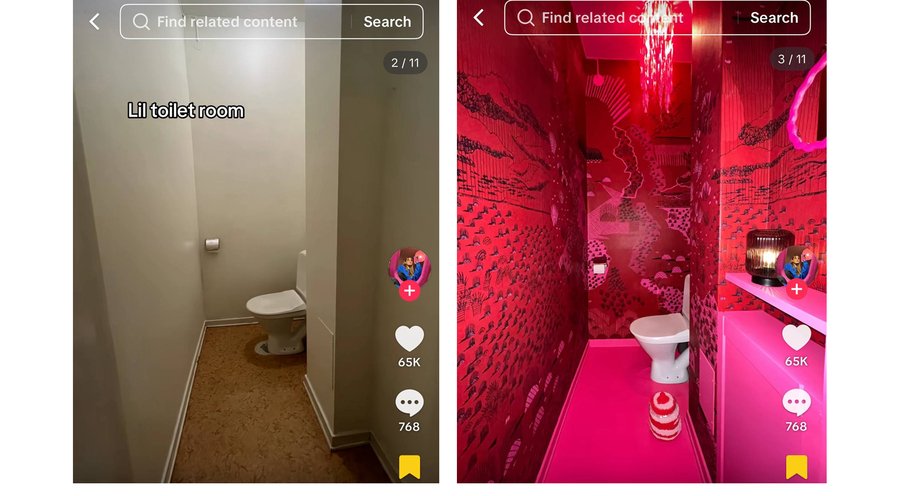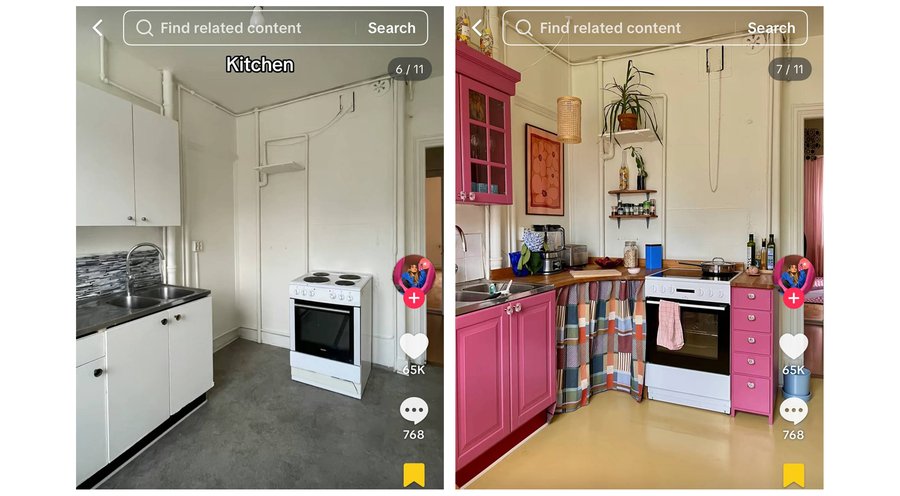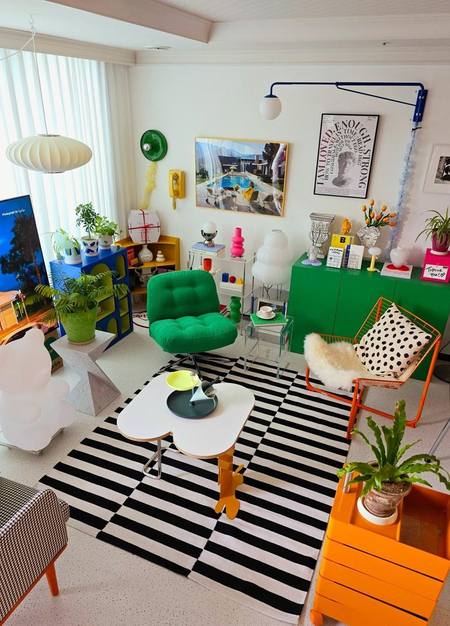
The «Dopamine Home» Trend
Introduction
Lately on my social media, I keep coming across the trendy colourful, vibrant, very bold interior design. I like watching graphic design content because I am a graphic designer myself, and I keep noticing something—each one of them has quite a similar colourful background, to be exact the very same interior design. This does not only apply to the graphic designers, of course, but also applies to other content creators on my feed: family, fashion, cafe set-ups, store curations.
The realisation that this is an actual trend came to me when I started seeing videos that were made on the topic of «dopamine decor». The more I dug into it, the more dopamine decor content I kept getting in my recommendations, and the more I started asking myself how did we get here.
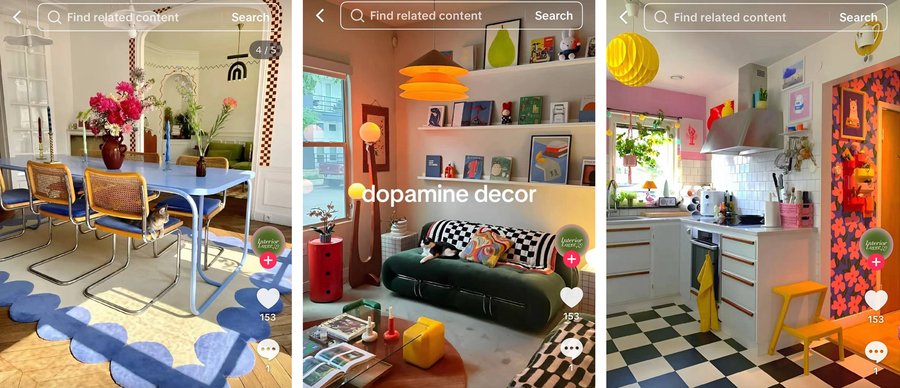
Post on Dopamine décor, Content creator intrrlvrPH, 2025
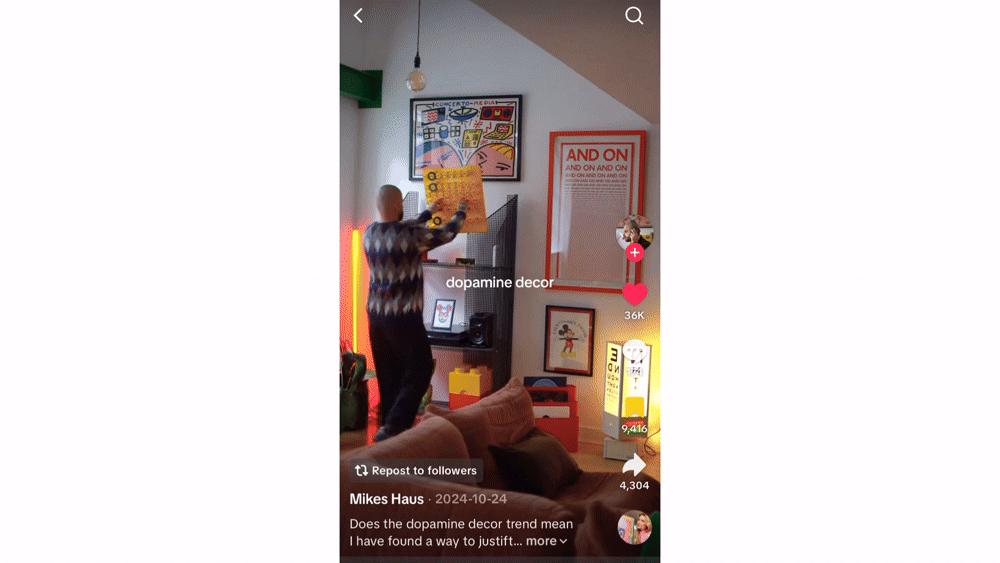
Content on Dopamide decor; Mikes Haus; 24.10.2024
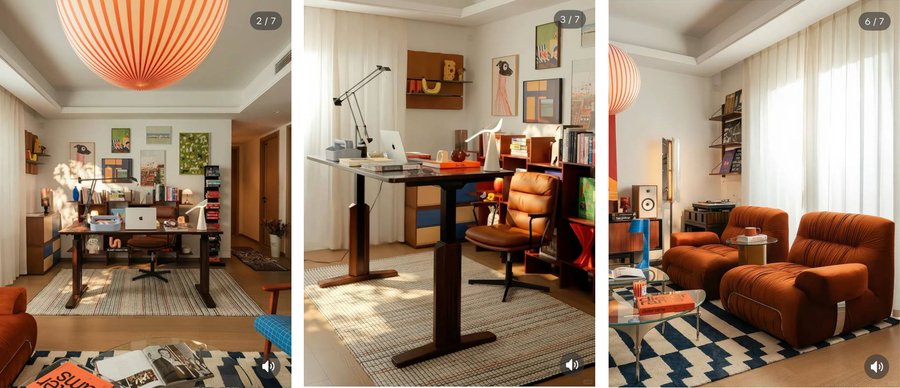
Interior design with a hash tag midcenturymodern, content creator Gizuals, 2025
Comment section and reaction to the dopamine home challenge
Just a few years ago, everyone was moving towards some sort of minimalism in their homes. Just to clarify, I am talking about the homes of a normal person, who is not into any sort of design. But now everything has gained such a drastic change, to something so different.
The contrast is striking when you think about it. For nearly a decade, minimalism dominated not just design magazines and Pinterest boards, but actual living spaces. White walls, beige sofas, clean lines, and the famous «less is more» philosophy became the standard. People were decluttering, embracing neutral palettes, and finding peace in simplicity. It was everywhere—from Marie Kondo’s tidying methods to Scandinavian interior design taking over Instagram. The aesthetic was calm, controlled, and undeniably safe. There was something comforting about it, a sense of order in a chaotic world. But somewhere along the way, things started to shift. The beige began to feel boring. The neutrals felt, well, too neutral. And suddenly, colour exploded back into our spaces with a vengeance.
So here is the main question: while colourful and expressive interior designs have become increasingly popular, what exactly is driving this massive shift towards this? Is it purely a natural reaction after years of minimalist spaces—or are we witnessing something more complex? Could social media algorithms be creating a chain consumer reaction, where everyone seems to be getting what the have been convinced looks gooa ans i curently on trend? Or perhaps there’s a deeper cultural and psychological reason at play, where people are craving spaces that feel alive and personal after years of neutrality.
Understanding what’s really fueling this trend could reveal important insights about how we express identity through our environments today.
While having a quick look at it, a couple of assumptions could be made. People are simply trying to change it up, move away from the very settled, clean interior design and try to go towards something more bold that reflects their personality a bit more. Also, social media has normalised these bright and colourful experiments for us, attracting more and more people to try it for themselves. In this visual research, we are going to have a closer look at all of the possible causes behind this shift, and after that we will see whether our initial hypothesis will remain true.
Minimalism
One of the first logical explanations for the ongoing trends that we see all over social media is that this is a reaction to the minimalism that dominated interior design in the last decade. This style was characterized by plain, neutral-colored walls, pared-down furnishings, and a lack of ornamentation. It embraced very clean lines, with little-to-no experimentation with color, creating spaces that felt more «sterile» or calm, with a focus on openness. In my opinion, these spaces also felt somewhat impersonal or distant at times, lacking the warmth and textures found in mid-century interiors. It was essentially a «bare essentials» approach.
This type of interior design became particularly prominent during the beginning of the 2000s, specifically around 2010-2020. We see this aesthetic in the work of designers such as John Pawson, who pioneered contemporary minimalism and is often regarded as one of the key figures in modern minimalist design. Minimalism also appeared in high-profile homes, such as Kim Kardashian and Kanye’s house, which was purchased in 2014. However, minimalism was not limited to the wealthy—this trend also found its way into the average person’s home, as evidenced by the Pinterest posts and social media trends that proliferated during this time.
Rural retreat in a minimalistic style, John Powson, 2020; Foro table for Viccarbe, John Pawson, 2022
ean Royère armchair, coffee table by Axel Vervoordt; The hallway; Armchair and coffee table Jean Royère in Kim Kardashians home
Ceramic vases by Shiro Tsujimura, kitchen in Kim Kardashians home
Pinterest suggestions to the search, Minimalistic interior design 2010
But something that people might not notice is that this is part of a circular rotational process, and the colorful and bold movement we see on social media today is, in a way, very predictable, because we have seen a similar pattern before.
Let’s take a look at another important movement, mid-century modernism, which we’ll revisit a bit later. Mid-century modernist interior design emerged after the Art Deco movement in interior design, which was characterized by bold geometric shapes, symmetry, and vibrant colors like greens and blues, along with luxurious metallics like gold and silver. Something interesting to note here is what happened after the modernist minimalism movement? By the 1970s, towards the end of mid-century design, some designers began to rebel against its simplicity, functionalism, and clean, uncluttered aesthetic. They wanted to incorporate bright, bold colors and patterns that were very different from the subtle tones that had dominated prior designs. They also embraced glossy materials, such as plastics, and experimented with textures and irregular shapes to inject more personality and fun into their creations.
These designers even started their own collective called the Memphis Group, which rejected the modernist notion that form must always follow function. Instead, they embraced a more expressive, decorative, and emotionally charged approach to design. Notable designers in this movement included Ettore Sottsass (the founder of the Memphis Group), Michele De Lucchi, Paolo Rizzatto, and Alessandro Mendini.
Ultrafragola mirror/lamp, 1990, Ettore Sottsass
Sottsass Sofa, 1981, Ettore Sottsass; Asteroid lamp, 1968, Ettore Sottsass
Ceramic Bambole series, 1994, Ettore Sottsass; Kristall, 1981, Michele de Lucchi; Sinerpica Lamp, 1979, Michele de Lucchi
This, in a way, proves our suggestion and even gives us a bit more insight than we initially thought. This isn’t just a simple reaction to the minimalism that preceded it; it’s part of a cyclical process where trends naturally evolve and return. Every now and then, people gravitate back to once-forgotten styles. We could even make the assumption that, at some point in the future, we’ll see a resurgence of more deliberate design choices in our interiors—something that’s a bit more minimalistic but settled, reflecting a balance between the boldness of recent trends and the simplicity of earlier styles.
Social Media influence
What if we look at this from a different angle? What if this is simply social media doing its thing? We live in a time when we consume far more products than we actually need, and influencers who create content around these products play a significant role in this behavior.
It’s easier than ever to keep up with new trends—whether it’s trendy cafes that open in town, the latest movies, fashion, or of course, interior design trends. Ordering interior products is no longer a hassle; everything is incredibly accessible now, with worldwide shipping options and products available for all budgets. Whether you opt for designer pieces or cheaper dupes, there’s always an option within your reach. In fact, social media platforms have simplified this process even further by integrating shopping features directly into the platforms themselves. You no longer need to search for products on external websites—an influencer might post a video showing off a cool lamp they just bought on TikTok, and tell you that it’s available in their TikTok shop. With a simple click, you can have it delivered to your door.
hanging elements in your interior not because you are looking for change, content creator mr.harry.white, 06.02. 2024
This level of accessibility and convenience is unprecedented, and it’s one of the reasons why trends evolve at lightning speed. We now see people posting about their dopamine interiors on social media, and interestingly, these spaces often have a very similar look and feel. It’s as if everyone is influencing each other, and people are getting the same products for their homes. The influencer culture has led to an echo chamber effect where style trends and products are recycled and redistributed across countless homes, resulting in very similar aesthetic choices, regardless of location or personal taste.
Comparing this to the past, during the postmodernist era, trends also shifted, but at a much slower pace. The production and availability of interior design pieces were far more limited, and so each home, even though following similar trends, might have had a distinct set of items due to availability constraints. The large quantity and accessibility of design products today make the current trend explosion feel much more homogenized.
What’s also interesting is how many design pieces today echo past movements, like mid-century modern, art deco, and postmodernism. For example, the Arc lamp by Achille and Pier Castiglioni (1962) is a popular choice in modern interiors for its sleek curve and minimalist design. The Togo lounge chair, designed by Michel Ducaroy in 1970, with its relaxed, modular shape, has become a go-to piece for contemporary comfort and style. The Akari lamp by Isamu Noguchi (1951), with its organic form and blend of Eastern and Western influences, continues to illuminate modern homes. These pieces show how design trends are circular, with elements from the past making a vibrant comeback in today’s interiors.
Pinterest social media fall 2025 report, shows an increased interest for Art deco interior design
Trending Akari lamps, StackedStore, 25.03.2025
Akari 75A lamp, Isamu Noguchi, 1951; Akari 75A lamp, Isamu Noguchi, 1951; Akari 26A lamp, Isamu Noguchi, 1951
Akari lamp, 2023
Eames Lounge Chair and Ottoman by Charles and Ray Eames 1956
Eames Lounge Chair in todays interior design, content creator Georgene Loh, 18.03.2023
Original Sunburnt Orange fabric 'Togo' Sofa by Michel Ducaroy for Ligne Roset, Togo lounge chair, Michel Ducaroy, 1970
Ligne Roset advertisement, editorial spread, Togo sofa, 1970s
Internets most favorite sofa video, content creator Apin, 2024; Content on the viral togo sofa, Content creator Itsonthethirdfloor 2024
The Influence of Gen Z and Millennials
What if we consider the main driving force behind the rise of dopamine interior design as being the generation that’s participating in it? Specifically, the Gen Z and Millennials—the people shaping the future, moving into new apartments, opening businesses, and building the future. This generation is known for their constant pursuit of self-expression and their drive to romanticize life through aesthetics.
The spaces around them matter more than ever before. You’ll find them flocking to aesthetic cafes, seeking out the perfect setting for their Instagram-worthy cappuccinos, visiting curated libraries, and working in visually stimulating co-working spaces. Their homes, of course, reflect this same mindset—they want their environments to match their needs and aesthetic. We see more and more content with captions such as,"This is why i like staying at home» or " Reasons why I dont like leaving my home» during this trend. People set up and decorate their spaces custom to their personalities and personal view on what is aesthetic building a space that they are proud of being in. Embracing this viral interior design trends—a space that radiates energy, personality, and warmth.
Content under caption «This is why i like staying at home „, content creator Gian Wong, 2025
Furnishing your apartment in your 20s, content creator Cata haus, 2024
This trend is growing so quickly because of the participation of these generations. Gen Z and Millennials are consuming more content than ever, especially content related to interior trends. As these generations spend time searching for design inspiration, they start to internalize these styles, identify their preferences, and eventually purchase products that align with those preferences. The viral interior design trends are inherently colorful and vibrant, offering plenty of room for experimentation—which, as we know, is exactly what the new generation craves.
Platforms like Pinterest give us direct insight into the most frequent searches and the age groups behind them. With this data, we can see that young people are gravitating toward these vibrant and playful interiors, where they can express their unique personalities.
Data from Pinterest trend analytics, showing how distribution is between Gen z and millennials, 2023-2025
Furthermore, DIY (Do-It-Yourself) has become a fun, accessible activity for the new generation. DIY isn’t just about saving money—it’s about creating something personal, adding your own touch to the space around you. This is where self-expression meets functionality. The rise of DIY culture also played a huge role in democratizing design, making it more affordable and approachable for people renting homes. Here’s where it gets interesting: a lot of people today are renting apartments and homes, and that comes with limitations. You can’t always paint the walls, change the tiles, or renovate the kitchen. But now, there are so many products on the market that allow renters to customize their spaces without making permanent changes. Peel-and-stick wallpapers, removable wall decals, temporary furniture, and decor accessories make it easy to personalize a space without worrying about it being a long-term commitment.
Before and after of a rental apartment, Content creator Hanna KL, 2024
Diy interior content, content creator Maitri, 2025
Removing all the rental friendly DIY, content creator Adrian Vazquez, 2025
Customization using rental friendly diy, content creator Juan Marquez, 2025
This growing availability of customizable, rental-friendly solutions has empowered young people to experiment with design in a way that feels authentic and fun. The freedom to personalize, express individuality, and keep up with the latest trends has made this viral interior design style a perfect fit for the current generation.
What stands out most about this particular trend is how people are turning to mid-century designs that were once considered dated or out of style. Pieces like the Eames Lounge Chair, Togo Sofa, and Akari Lamps are being reintroduced into modern homes, showing that people are reaching back to those forgotten designs. It’s interesting to see how these items from past eras are coming back and gaining popularity, and it speaks to the cyclical nature of design.
Conclusion
After looking at all these factors, it’s clear to me that the viral interior design trend we’re seeing today is really a result of a combination of things, but most importantly, it’s part of a pattern we’ve seen before. If we take a step back, we can see how trends often follow a cyclical pattern. After years of minimalist interiors, people naturally moved towards something more colorful, expressive, and fun, like the interiors we see now. This isn’t something unexpected—it’s just how trends work. After one trend reaches its peak, we often move toward the opposite, and then back again.
What stands out most about this particular trend is how people are turning to mid-century designs that were once considered dated or out of style. Pieces like the Eames Lounge Chair, Togo Sofa, and Akari Lamps are being reintroduced into modern homes, showing that people are reaching back to those forgotten designs. It’s interesting to see how these items from past eras are coming back and gaining popularity, and it speaks to the cyclical nature of design.
One of the biggest reasons this trend is moving so fast is because today’s generations have all the tools to participate in it. Gen Z and Millennials, who are shaping today’s trends, have easy access to everything they need to bring these designs to life. With online shopping, DIY options, and the power of social media, people can find and customize their homes more easily than ever. Social media plays a huge role in this, pushing trends across platforms like Pinterest, Instagram, and TikTok at lightning speed. This level of accessibility means that people can experiment with their spaces and follow the latest trends without waiting for them to spread slowly like in the past. So, while this viral design trend is exciting and fast-moving, it’s ultimately just another example of the pattern repeating itself. People always go back to what was once popular, and with all the tools available today, it’s easier than ever for them to do so. This trend is not a random shift; it’s a natural progression in the cyclical world of design. It’s something we’ve seen before, and it will likely happen again.
The materials presented in this research, including images and videos, were sourced from various online platforms, primarily from content creators found on social media. All videos, screenshots, and images used are credited to their respective creators, whose names can be found directly in the captions under each video, on the screenshots included in this research or the image source list.
SOURCES AND LINKS
Pamono. «Minimalist Furniture Design: History & Essence» [Electronic Resource] // Pamono. URL: https://www.pamono.com/stories/minimalist-furniture-design-history-essence (accessed: 05.11.25)
Dezeen. «John Pawson» [Electronic Resource] // Dezeen. URL: https://www.dezeen.com/tag/john-pawson/ (accessed: 05.11.25)
Good Moods. «Chez Kim & Kanye» [Electronic Resource] // Good Moods. URL: https://www.goodmoods.com/en/news/chez-kim-kanye-en (accessed: 05.11.25)
Poltronova. «Ultrafragola» [Electronic Resource] // Poltronova. URL: https://www.poltronova.it/ultrafragola/ (accessed: 05.11.25)
ArchDaily. «Aesthetic Trends and Accessibility: Interior Design in the Age of Social Media» [Electronic Resource] // ArchDaily. URL: https://www.archdaily.com/998678/aesthetic-trends-and-accessibility-interior-design-in-the-age-of-social-media (accessed: 05.11.25)
Architectural Digest. «Gen Z Interior Design Aesthetics» [Electronic Resource] // Architectural Digest. URL: https://www.architecturaldigest.com/story/gen-z-interior-design-aesthetics (accessed: 05.11.25)
Pinterest. «Pinterest Predicts 2025: Surreal Soirées» [Electronic Resource] // Pinterest. URL: https://business.pinterest.com/en-gb/pinterest-predicts/2025/surreal-soirees/ (accessed: 05.11.25)
Noguchi Shop. «Akari 75A» [Electronic Resource] // Noguchi Shop. URL: https://shop.noguchi.org/products/akari-75a (accessed: 05.11.25)
The Millie Vintage. «The History of Michel Ducaroy’s Togo» [Electronic Resource] // The Millie Vintage. URL: https://www.themillievintage.com/design-living/the-history-of-michel-ducaroys-togo (accessed: 05.11.25)
Tarkett. «What Is Scandinavian Interior Design Style?» [Electronic Resource] // Tarkett. URL: https://home.tarkett.com/en_EU/node/what-is-scandinavian-interior-design-style-8846 (accessed: 05.11.25)
Domus. «Ettore Sottsass and the Roots of Dutch Design» [Electronic Resource] // Domus. URL: https://www.domusweb.it/en/design/2017/11/02/ettore-sottsass-and-the-roots-of-dutch-design.html (accessed: 05.11.25)
Duende Press Relations. «Italian Lights at BSL Gallery» [Electronic Resource] // Duende Press Relations. URL: https://duendepressrelations.wordpress.com/2011/05/19/italian-lights-at-bsl-gallery/ (accessed: 05.11.25)
Tarkett. «What Is Scandinavian Interior Design Style?» [Tarkett]. URL: https://home.tarkett.com/en_EU/node/what-is-scandinavian-interior-design-style-8846 (accessed: 05.11.25)
Domus. «Ettore Sottsass and the Roots of Dutch Design» [Domus]. URL: https://www.domusweb.it/en/design/2017/11/02/ettore-sottsass-and-the-roots-of-dutch-design.html (accessed: 05.11.25)
Duende Press Relations. «Italian Lights at BSL Gallery» [Duende Press Relations]. URL: https://duendepressrelations.wordpress.com/2011/05/19/italian-lights-at-bsl-gallery/ (accessed: 05.11.25)
Pinterest. «Mid-Century Modern Interior Design» [Pinterest]. URL: https://www.pinterest.com/pin/1119144576254939087/ (accessed: 05.11.25)
Good Moods. «Chez Kim & Kanye» [Good Moods]. URL: https://www.goodmoods.com/en/news/chez-kim-kanye-en (accessed: 05.11.25)
Loi. «Should I make more of these kinds of videos? Also, which one is your fav?» [TikTok] // TikTok. URL: https://vm.tiktok.com/ZMA3EvUvT (accessed: 05.11.25)
Loi. «Exploring Vibrant Home Ideas» [TikTok] // TikTok. URL: https://vm.tiktok.com/ZMA3Ev192 (accessed: 05.11.25)
Content Creator. «Mid-century Modern Home Tour» [TikTok] // TikTok. URL: https://vm.tiktok.com/ZMA3EnXeC (accessed: 05.11.25)
Content Creator. «DIY Home Ideas: Make Your Own Dream Space» [TikTok] // TikTok. URL: https://vm.tiktok.com/ZMA3o1SMg (accessed: 05.11.25)
Content Creator. «Colorful Home Decor Inspiration» [TikTok] // TikTok. URL: https://vm.tiktok.com/ZMA3E7gHC (accessed: 05.11.25)
Content Creator. «Reimagining Your Living Space» [TikTok] // TikTok. URL: https://vm.tiktok.com/ZMA3oeWDH (accessed: 05.11.25)
Content Creator. «Transform Your Home with Color» [TikTok] // TikTok. URL: https://vm.tiktok.com/ZMA3E7f4N (accessed: 05.11.25)
Maitri. «DIY Projects (Jan-April Round Up)» [TikTok] // TikTok. URL: https://vm.tiktok.com/ZMA3ojUvC (accessed: 05.11.25)
Content Creator. «Creating Fun and Unique Interiors» [TikTok] // TikTok. URL: https://vm.tiktok.com/ZMA3E7KUV (accessed: 05.11.25)
Content Creator. «Colorful & Playful Living Rooms» [TikTok] // TikTok. URL: https://vm.tiktok.com/ZMA3EKCLo (accessed: 05.11.25)
